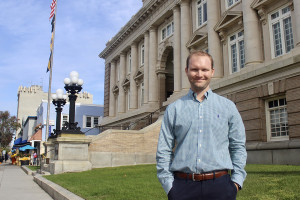Meet the Math Whiz Making an Impact in Local Healthcare
 Statistical analysis probably doesn’t come to mind when you hear “Main Line Health;” you’re probably thinking doctors, diagnosis or disease. But analyzing healthcare systems and their data is how Villanova University Master’s grad Meghan Buckley spends her days.
Statistical analysis probably doesn’t come to mind when you hear “Main Line Health;” you’re probably thinking doctors, diagnosis or disease. But analyzing healthcare systems and their data is how Villanova University Master’s grad Meghan Buckley spends her days.
The reason? As a biostatistician at the Lankenau Institute for Medical Research in Wynnewood, she works to improve community healthcare management and patient outcomes. She collects and organizes data to find solutions to the biggest issues impacting the area’s healthcare organizations. Issues like care inequality in underrepresented groups, healthy food initiatives for those lacking access to proper nutrition and ensuring quality care for all patients.
We sat down with her to learn more about the impact of her education at Villanova, how she found her field, and the bright future of Philadelphia’s healthcare systems.
What does a biostatistician do?
As a biostatistician at the Main Line Health Center for Population Health Research (CPHR) at the Lankenau Institute for Medical Research, I aim to identify and address disparities in healthcare, seek opportunities for quality improvement in patient care, and assess initiatives to improve the health status and quality of life in our patients, across a broad range of backgrounds. My team and I partner with community leaders, departments within the health system and individual researchers who share our goal of improving the lives of our community.
How does your role impact the community?
Although CPHR opened only two years ago, we’ve already had an immense impact on the lives in our community. One of my favorite projects is our partnership with the Deaver Wellness Farm, located on Lankenau Medical Center’s campus. The farm provides fresh produce and nutritional education to our patients, many of whom experience food insecurity. It’s my role to analyze patient surveys to better understand their views on this program, look at their suggestions to improve the program, and eventually, summarize the impact that the farm has had on managing patients’ chronic health conditions.
Biostatistics is a pretty specific field—how did you decide to pursue that as a career?
While I always enjoyed math, it was hard for me to envision what a career in math might look like. It wasn’t until I was introduced to statistics that I realized how much the world is guided by math and statistics. Ever since my first statistics course, I was hooked! Although I didn’t initially go into statistics with the vision of working in healthcare, I knew that whatever field I worked in, I wanted to make sure that my skills were being used to help others. Naturally when I heard about the role of biostatistics in healthcare, I knew it would be a good fit for me.
You received your Master of Science in Applied Statistics at Villanova in 2015—how did your degree prepare you for your current role?
I was initially drawn to the Applied Statistics program at Villanova because, unlike many other masters’ programs, it offered the opportunity to work as a graduate assistant while going to school full-time—allowing me to directly apply what I was learning in the classroom to real-world problems. This gave me the chance to collaborate and communicate with investigators in other fields, deal with complex data, and present my work at a conference. Thanks to those experiences, I can now clearly communicate my results with physicians, nurses and other researchers, who may have little to no background in statistics.
Do you use any of the skills you acquired at Villanova on a daily basis?
Absolutely! The lessons I learned in each and every Villanova class can be translated into my daily work. For example, the Design of Experiments course has allowed me to help my colleagues design and implement their research projects. Once data is collected, I use the skills I learned from the Statistical Programming course to compile, rearrange and clean up the data. To analyze the data, I rely on the skills I learned in my Statistical Methods, Regression Methods, and Linear Models courses. The well-rounded education that I received from Villanova has given me all of the tools I need to succeed as a statistician. Plus, many of my professors at Villanova serve as my mentors today.
What do you find most fulfilling about your job?
My job is fulfilling in many ways, aside from helping the local community, I find it very fulfilling to teach statistics to my colleagues. Often, I hear colleagues say, “I hate statistics” or “I’m not good with numbers,” only to find out that once I sit down with them and explain the results in ways that they can understand, they start to take ownership of their data and see its impact in the real world.
What advice would you give to students interested in pursuing a career in statistics?
First, research the different focuses of undergraduate or graduate statistics programs. I knew I was more interested in the applied aspect of statistics rather than the theoretical framework, so I pursued both an undergraduate and a graduate degree in applied statistics. It’s also important to keep in mind that many statistician jobs require at least a master’s degree. So, if you are an undergraduate student, I would suggest looking at the prerequisites for the graduate programs you’re interested in. Outside of the classroom, get as much hands-on experience as you can through internships and shadowing. Not only are they great networking opportunities, they will help you decipher what kind of career best suits your interests.
What’s next for you?
We’re working on a new partnership with the Women’s Heart Initiative to increase awareness that heart disease is the number one killer in women over the age of 25, and that heart disease presents differently in women than in men. Although this partnership is in its early stages, I’m currently designing a pilot study that will compare the symptoms of major cardiovascular events in males and females. There are always new and exciting developments taking place!
Learn more about Villanova’s Master of Science in Applied Statistics program.
This is a paid partnership between Villanova University College of Liberal Arts and Sciences and Philadelphia Magazine


